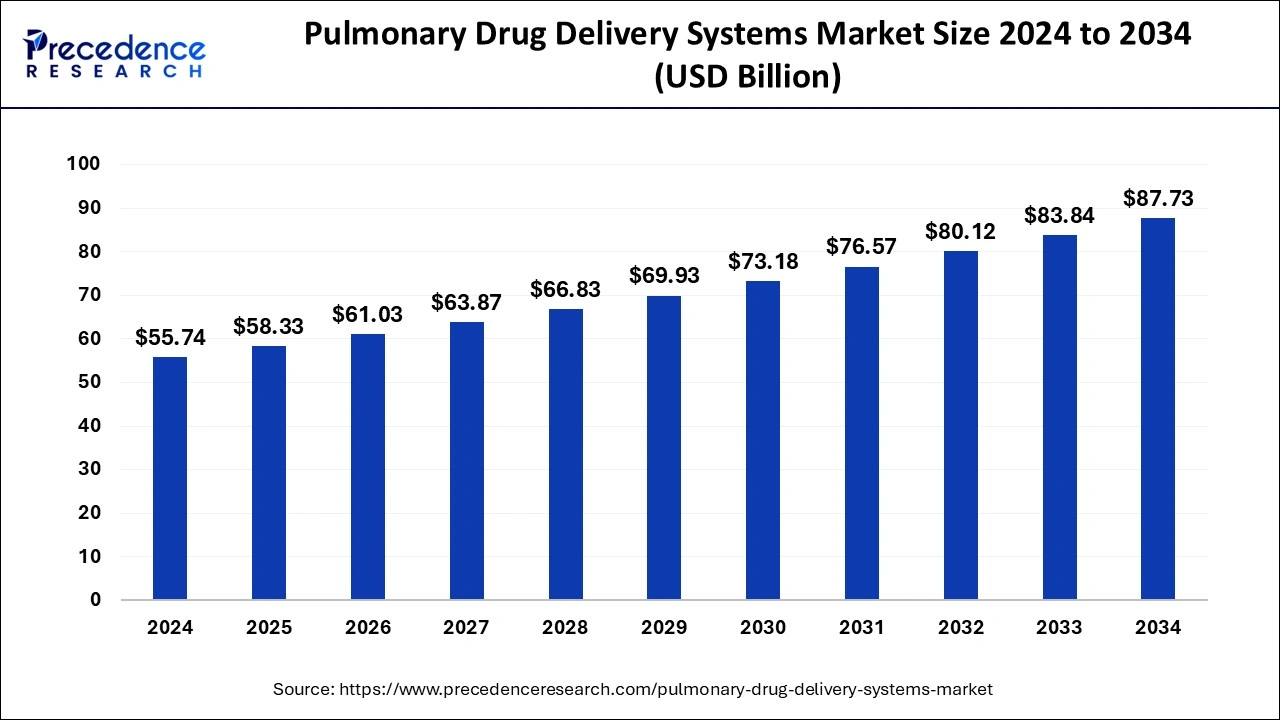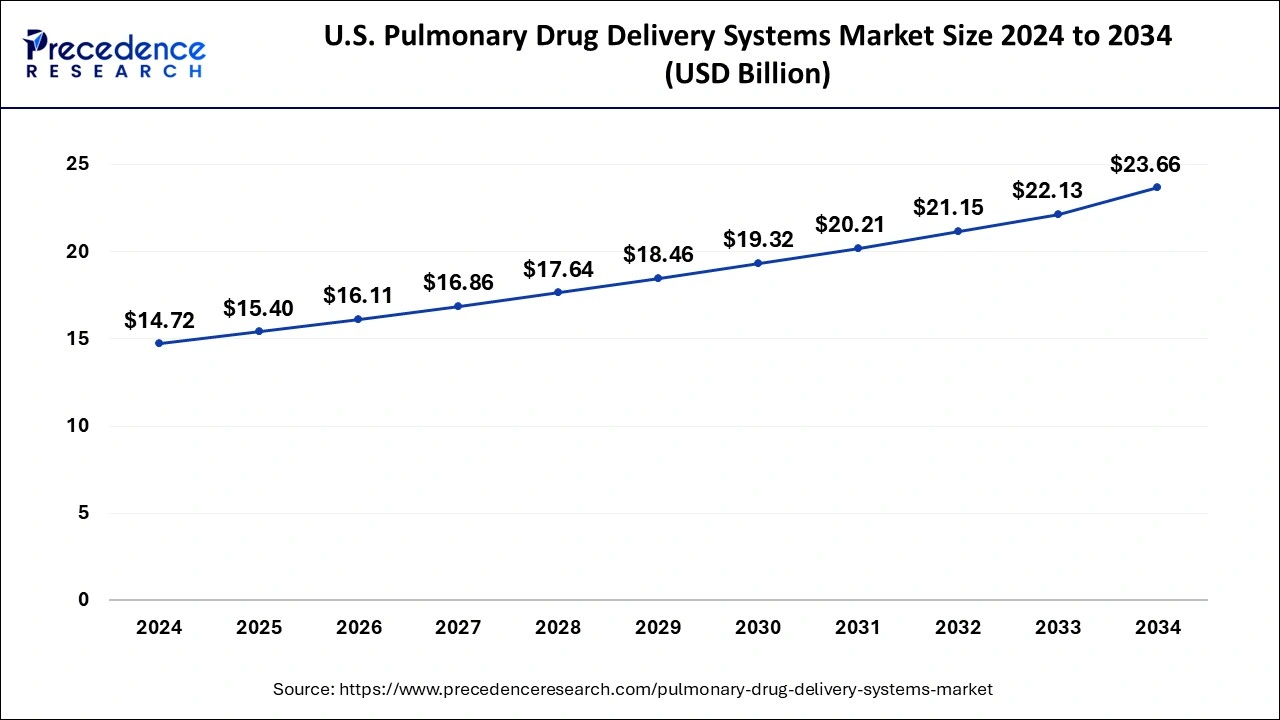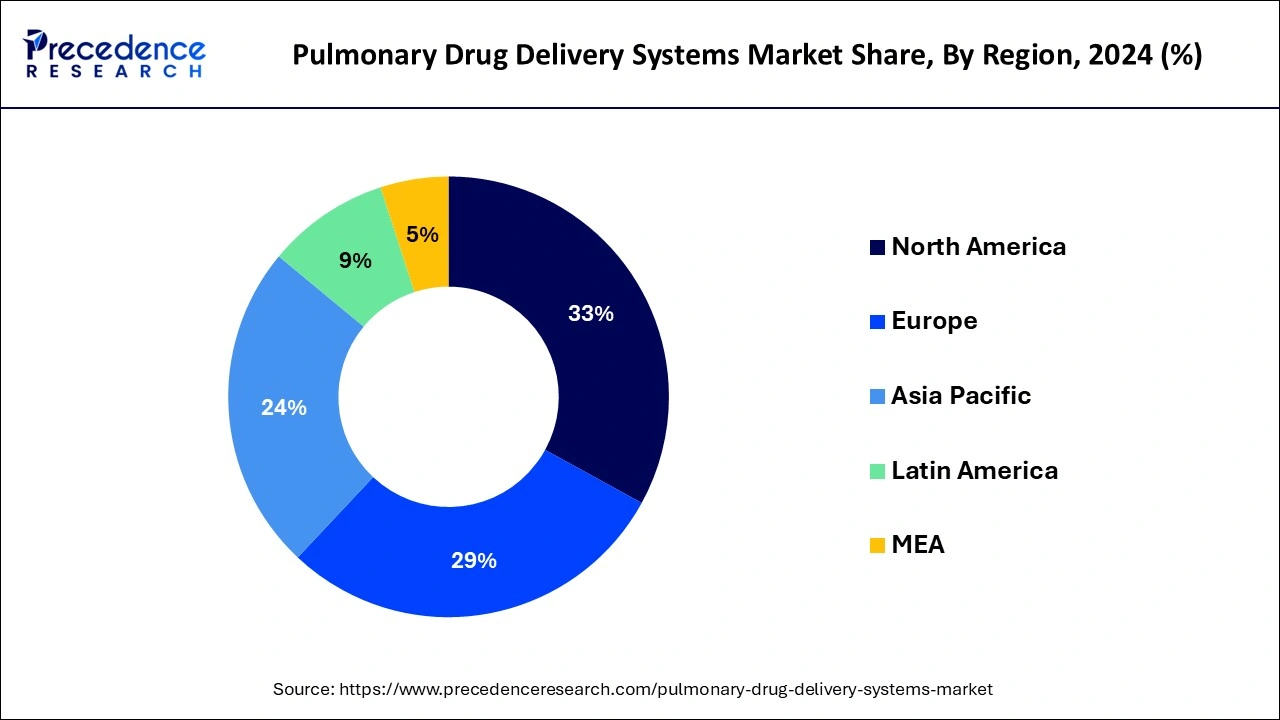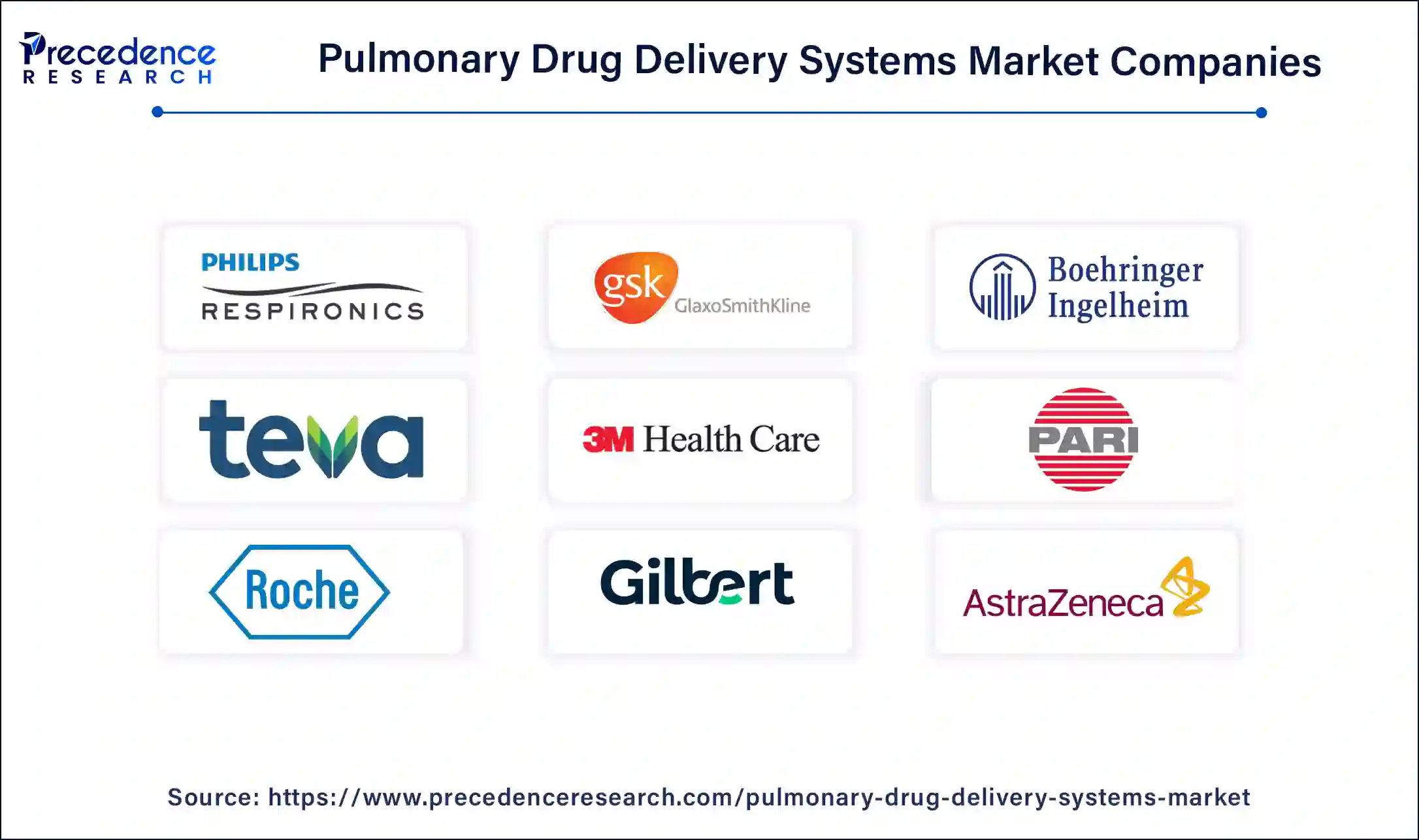November 2024
The global pulmonary drug delivery systems market size is calculated at USD 58.33 billion in 2025 and is forecasted to reach around USD 87.73 billion by 2034, accelerating at a CAGR of 4.64% from 2025 to 2034. The North America pulmonary drug delivery systems market size surpassed USD 18.39 billion in 2024 and is expanding at a CAGR of 4.80% during the forecast period. The market sizing and forecasts are revenue-based (USD Million/Billion), with 2024 as the base year.
The global pulmonary drug delivery systems market size was estimated at USD 55.74 billion in 2024 and is anticipated to reach around USD 87.73 billion by 2034, expanding at a CAGR of 4.64% from 2025 to 2034. The growth of the pulmonary drug delivery systems market is driven by the increasing prevalence of pulmonary diseases like chronic obstructive pulmonary disease (COPD), cystic fibrosis, and asthma.

The integration of AI and machine learning in drug delivery systems is considered as a cornerstone for the pharmaceutical industry. This integration uses computational power to transform conventional drug delivery systems by escalating the drug development process precisely. AI algorithms, like deep learning models, can predict the behavior of molecules, binding affinities, and possible toxicity of certain compounds by analyzing huge amounts of biological and chemical datasets and aid in shortening the drug discovery phase. These models are trained on huge historical data to predict which particular molecule structures are most likely to interact with certain biological targets, which can be done by integrating patient-centric data like genomics, proteomics, and metabolomics. AI-based drug delivery devices monitor the efficiency and behavior of drugs in real-time and provide essential health parameters, thereby improving patient outcomes.
The U.S. pulmonary drug delivery systems market size was evaluated at USD 14,72 billion in 2024 and is predicted to be worth around USD 23.66 billion by 2034, rising at a CAGR of 4.86% from 2025 to 2034.

North America dominated the global pulmonary drug delivery systems market with the largest market share of 33% in 2024. The increased prevalence of the pulmonary diseases in US have resulted in an increased demand for the pulmonary drug delivery systems. According to the American Lung Association, around 16.4 million people in US were diagnosed with some type of COPD such as emphysema, chronic bronchitis, and COPD. As per the Asthma and Allergy Foundation of America, around 25 million people were suffering from asthma in 2018 in US. Therefore, the increased prevalence of pulmonary diseases coupled with the increased awareness regarding the management of chronic conditions and high healthcare expenditure are the major factors that resulted in the growth of North America pulmonary drug delivery systems market.

Asia Pacific is poised to grow at the highest CAGR during the forecast period. The rapid industrialization and urbanization in the region is resulting in increasing pollution levels. The increased pollution in the air is a major cause of the pulmonary diseases. Moreover, higher mortality rates in this region due to the pulmonary diseases is expected to drive the demand for the pulmonary drug delivery systems. According to the WHO, around 80% of the death due to COPD occurs in the low and middle income countries. Therefore, the demand for the pulmonary drug delivery systems is projected to grow rapidly in Asia Pacific.
A pulmonary drug delivery system is a targeted drug delivery in which a part of the drug is directed toward the targeted site or the respiratory tract. Simply, the pulmonary drug delivery system is a device used for the administration of drugs through the pulmonary route for the treatment of various respiratory diseases. The rising prevalence of respiratory diseases such is the primary reason behind the burgeoning demand for pulmonary drug delivery systems across the globe. According to the World Health Organization, COPD is the fourth leading cause of death across the globe, causing approximately 5% of all global deaths.
| Report Highlights | Details |
| Market Size in 2025 | USD 87.53 Billion |
| Market Size by 2034 | USD 87.53 Billion |
| Growth Rate from 2025 to 2034 | CAGR of 5.60% |
| Largest Market | North America |
| Base Year | 2024 |
| Forecast Period | 2025 to 2034 |
| Segments Covered | Product, Indication, Distribution Channel, Region |
| Regions Covered | North America, Europe, Asia-Pacific, Latin America, and Middle East & Africa |
Conditions such as asthma, chronic obstructive pulmonary disease (COPD), chronic bronchitis, and lung cancer are becoming increasingly prevalent worldwide. This rise in respiratory conditions drives the demand for effective and convenient treatment options that can improve patient's quality of life, fueling the market growth. One of the most promising approaches to meet this demand is the use of drug delivery systems that deliver drugs directly to the lungs. This method offers several advantages, including bypassing the digestive system, leading to faster absorption and quicker therapeutic effects. By administering medication directly to the lungs, higher drug concentrations can be achieved in pulmonary tissues compared to traditional oral administration. This targeted approach enhances treatment efficiency and ensures patients benefit most from their medications.
High costs associated with pulmonary drug delivery systems hinder market growth. Due to the high cost of these devices, not everyone can take their advantage. Many advanced pulmonary drug delivery systems come with a high price tag, which may limit access for some patients who need them. Additionally, the complexity of certain devices can pose a barrier to effective use. Many of these inhalation devices require patients to have proper training and education to ensure they use them correctly and achieve the desired therapeutic outcomes.
There is a growing interest in integrating sensors and digital technologies into drug delivery systems. Such innovations allow for real-time monitoring of drug delivery, providing valuable feedback to patients and healthcare providers. This data-driven approach can help tailor drug delivery systems to meet patients' individual needs and adapt to their specific disease severity. Furthermore, there is a strong emphasis on developing drug delivery devices that are capable of delivering multiple drugs simultaneously. This capability could significantly enhance treatment regimens, making it easier for patients to manage their conditions with fewer devices and dosing schedules. Advancements in drug delivery technologies, such as dry powder inhalers, nebulizers, and metered-dose inhalers, are expected to boost the growth of the market in the coming years.
The metered dose inhalers segment contributed the highest market share in 2024. and dominated the global pulmonary drug delivery systems market. The key market players and their innovative metered dose inhalers have gained traction among the consumers and resulted in the dominance of this segment across the globe. The higher product acceptance among the consumers coupled with the increasing rise in the prevalence of pulmonary diseases has fostered the growth of the metered dose inhalers segment.
On the other hand, the nebulizers segment is expected to grow at a significant CAGR from 2025 to 2034. Nebulizers offers various benefits such as favorable reimbursements, comfort, and easy administration of large doses, which makes it suitable for emergency and at-home use. Hence, this segment is expected to gain rapid traction in the foreseeable future.
The asthma segment captured the biggest market share in 2024. Asthma is a major non-communicable disease that affects both children and adults, as per the WHO. Rapid urbanization and changing lifestyle is a major reason behind the rising prevalence of asthma. The rising awareness regarding the management of asthma and easy availability of the pulmonary drug delivery systems has fueled the growth of this segment over the past years.
The allergic rhinitis segments is estimated to be the fastest-growing segment during the forecast period. The surging uses of dry powder inhalers, nasal sprays, and allergy shots for the treatment of allergic rhinitis is boosting the revenues of this segment. Furthermore, the rising prevalence of allergic rhinitis among the population is boosting the growth of this segment.
Depending upon the distribution channel, the hospital pharmacy segment dominated the global pulmonary drug delivery systems market in 2024. Hospitals provide quick treatments, east reimbursements, and extensive care, which has contributed towards the dominance of this segment. Moreover, wider availability of the pulmonary drug delivery devices in the hospital pharmacy makes it a popular choice among the patients.
E-commerce is estimated to be the most opportunistic segment during the forecast period. The rising penetration of internet, increasing adoption of smart devices, growing penetration of the online pharmacies across the globe, and quick home delivery services provided by them are the major factors that are expected to drive the growth of this segment in the forthcoming years.
The key market players are constantly engaged in various developmental strategies such as product launches, collaborations, and partnerships in order to establish their supremacy in the market and gain competitive edge over others. These developmental strategies are expected to provide new growth prospects in the forthcoming future and will foster the growth of the global pulmonary drug delivery systems market.

By Product
By Indication
By Distribution Channel
By Geography
For inquiries regarding discounts, bulk purchases, or customization requests, please contact us at sales@precedenceresearch.com
No cookie-cutter, only authentic analysis – take the 1st step to become a Precedence Research client
November 2024
November 2023
August 2024
June 2023